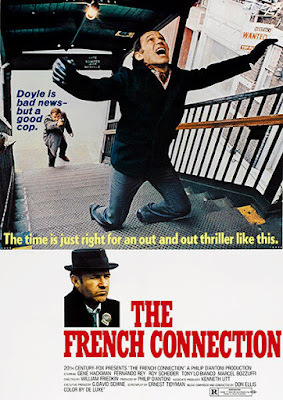Chasing After “The French Connection”

Some years ago, backstage atthe West Hollywood Festival of Books, I chanced to chat with William Friedkin.It wasn’t much of a conversation: I was hardly a fan of The Exorcist,and didn’t have much in the way of insider questions to pose to the famousdirector. Nor did he seem to really welcome my interest in his career. Still,he was an Oscar winner, and a leading light among the New Hollywood filmmakersof the 1970s. So the news of his passing sent me to re-watch his most acclaimedthriller, 1971’s The French Connection.
Despite its title, most ofthis down-and-dirty film is set in the mean streets of New York City. In earlyscenes I was pleased to see a few genuine glimpses of the Vieux-Port ofMarseille, where some European baddies are planning a major drug deal, sending$32 million worth of heroin to the Big Apple in the trunk of a car beingshipped across the Atlantic. By the time they and the dope arrive, two scruffyNYPD detectives (played by Roy Scheider and the Oscar-winning Gene Hackman) areon their trail, and most of the film becomes a cat and mouse game, with thecops pursuing the “frogs” through dingy alleyways and traffic-heavy streets.The mid-film chase involving a hijacked commuter train pursued by Hackman (as“Popeye” Doyle) in a commandeered sedan is what stood out in my mind from mylong-ago first viewing of this film, and it’s just as exciting now, some fifty yearsafter the initial release. (Wow! – the woman with the baby carriage really setsthe heart athumping.) But there are lots of other great action sequences aswell. I’ve read that in directing thisfilm, Friedkin took his inspiration from the French thriller Z, in whichdirector Costa-Gavras filmed a fictional story about a political assassinationin documentary fashion, thus heightening its drama. As Friedkin was to put it,“It was a fiction film but it was made like it was actually happening. Like thecamera didn't know what was gonna happen next.” With Z as a model, he shot The French Connection similarly,using a sense of rawness and uncertainty to pump up the adrenaline of audiences.
I was surprised to learn thatthe budget was a modest $1.5 million, though the filmmakers went $300,000 over.But because of what was, even in the Seventies, modest budgeting, Friedkincouldn’t hire a glamorous star like Paul Newman or Steve McQueen. Tough guysLee Marvin, Peter Boyle, James Caan, and Robert Mitchum turned down the Popeye role,which eventually went to Hackman. He had Hollywood cred, including a SupportingOscar nomination for Bonnie and Clyde in 1967, but The FrenchConnection is what truly put him on the map.
Though Popeye and his partnerare based on specific New York cops, I was surprised this time around torecognize that the film makes little effort to characterize them outside oftheir on-the-job behavior, Popeye’s pork-pie hat, and his leering way ofchallenging others: “Do you pick your feet?” Frankly, they seem to have no lifebeyond their profession. Their language is raw and their behavior is oftenbeyond the pale. In fact we learn that a former partner of Popeye’s died when oneof his hunches backfired. Even when Popeye and Cloudy ultimately triumph,there’s a painful irony: the final crawl makes clear that none of thedrug-runners they’ve brought down ever really faces serious punishment, and thekingpin of the whole operation gets away scot-free. Just another day in thelife of New York’s Finest.
Beverly in Movieland
- Beverly Gray's profile
- 10 followers



